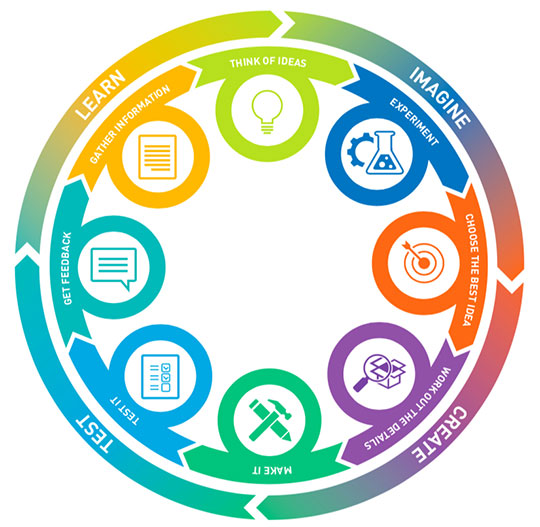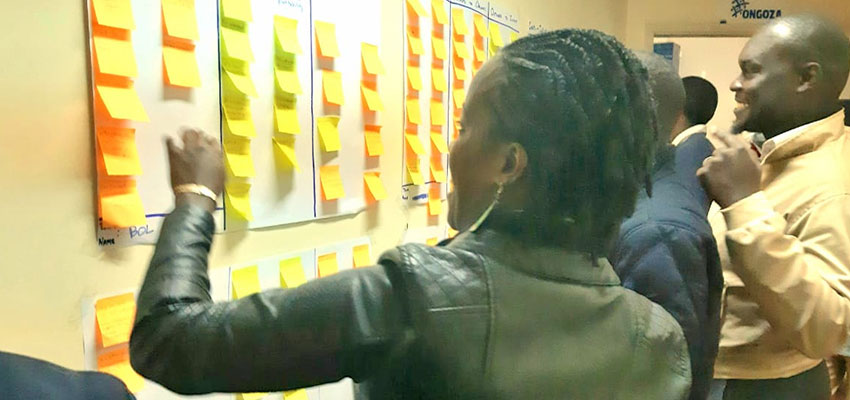
Flaring Out to Focus In
MIT D-Lab’s design cycle follows four simple and sequential phases: Learn, Imagine, Create, Test (...and repeat). The modes of thinking and behaviors we bring into each of these Design Cycle steps are crucial to ensure a participatory design process and a solution that works for the end user. Moving from an information gathering stage to a problem definition stage requires a collective mindset shift from flaring out (divergence) to focusing in (convergence). This enables everyone involved in the design process to avoid jetpacking to a solution that overlooks the needs and requirements of the user. This summer, in Nairobi, Kenya, I aimed to facilitate these fluid shifts from flaring to focusing to co-design a usable monitoring and evaluation framework with MIT D-Lab Innovation Ecosystem Builder Fellow organization, Ongoza.

Ongoza is an entrepreneurship accelerator focused on supporting and growing Kenyan enterprise to tackle the country-wide challenges of youth unemployment (estimated between 25-40%) and small enterprise survival rates. Ongoza has been serving entrepreneurs with a unique one-year long one-on-one business advisory service since 2013 (and with an 8-week business fundamentals course since 2018), with the aim of growing companies’ revenue to create new, stable jobs for the Kenyan youth. Ongoza’s multi-faceted and talented staff, which includes business development advisors, recruitment specialists, and a data and learning team, coordinate to identify, train, and advise entrepreneurs all while tracking the entrepreneurs’ business growth and program engagement. During my first two weeks in Nairobi, I flared out and conducted interviews using Lean Interview tactics with 25 members of Ongoza’s Nairobi and Nakuru staff, leadership team, and board. My goal: to better understand the differing staff perspectives on how Ongoza’s program design and delivery ultimately leads to the organization’s desired impact.
Across Ongoza’s departments, which provide different activities in service of Ongoza’s broader impact goals, I began to notice slight differentiations in the way Ongoza’ staff and board saw the organization’s role and mission as an actor in Kenya’s entrepreneurial ecosystem. Mindful of these variations gathered in my project’s Learn phase, I started wrestling with this vast collection of qualitative data. Piecing this data together, I focused in on a crowdsourced, all-staff-generated Theory of Change Framework.
With a holistic Theory of Change Framework, Ongoza could create a simplified, usable map that connects their core programmatic activities to short-term outcomes within the organization’s control. Ongoza could then utilize this Theory of Change to routinely verify whether their programmatic outcomes are feeding into to the organization's desired broader impact on Kenya’s entrepreneurial ecosystem, youth unemployment rate, and business survival rate.
Building Buy-In and an Outline
To complete the convergence step, and test whether the Theory of Change framework would be useful to Ongoza’s team as a tool to monitor the organization’s impact, it was important to confirm that the framework would serve the needs of Ongoza’s leadership team and staff. To do this, I created a “skeleton” Ongoza Theory of Change from a thematically-grouped analysis of my interview data that tagged staff interview answers to the four Theory of Change steps (the organization’s Activities, Outputs, Outcomes, and Impact) and presented it in an all-staff meeting. First, I walked the staff through the Theory of Change framework (utilizing many nerdy M&E memes) and explained how it could be useful from the perspectives of Ongoza’s different departments (fundraising, marketing, recruiters, advisors, trainers, and data managers). Next, I started to gather feedback (flaring out, once again...) from the entire staff while building staff suggestions into a Theory of Change framework. To ensure that Ongoza’s Theory of Change reflected the desired goals of the entire staff, we added in new core components into the skeleton Theory of Change including Ongoza’s marketing and recruitment events as a core program Activity, business practice adoption and confidence as a desired Outcome, and Kenyan small- and micro-sized enterprise survival and formalization as a chief Impact goal. Ongoza staff members not only wanted to see their training program and one-on-one advisory service lead to increased revenue growth and job creation, they also wanted to track whether their core services aligned with the end goal of decreasing small business closure rates and enabling companies to adopt best business practices to operate efficiently and reach profitability.
We were making great progress on developing a useful M&E framework for Ongoza through crowdsourcing and curating the staff’s perspectives and feedback and identifying the outcomes and impact that the staff wanted to see as a result of their work, but we were still short a critical piece: the means in which to test and validate the steps of the Theory of Change.

Crowdsourcing and Curating a “Complete” Theory of Change
To complete Ongoza’s Theory of Change Framework, we needed to flesh out the assumptions we were making between the framework’s steps. In shorthand, the Theory of Change was missing an exploration of the underpinning factors that could undercut the links between Activities and Impacts. Using exercise tools and strategies from D-Lab, I worked with Ongoza’s senior leadership and business development advisors to design an all-staff workshop to generate assumptions for each step of the Theory of Change (Activities to Outputs, Outputs to Outcomes, Outcomes to Impact). The organization could then use these assumptions as validation questions to consistently test their pathway to their impact goals. The Assumption Generation Workshop was set up to continue crowdsourcing additional insights from the Ongoza staff to complete a Theory of Change framework with all-staff support and alignment. Once again, we were collectively flaring out in a Create phase to absorb a volume of input necessary to build out a useful, Ongoza-centered Theory of Change.
I wanted to be sure that the workshop remained active, collaborative, visual and loosely flowing, in order to maintain a high-energy level, catalyze the staff’s creativity, and build buy-in for the Theory of Change tool. The workshop began with a restatement of the Theory of Change outline and an open discussion on the importance of setting up checks to validate the Theory of Change pathway. We then began to form into teams of 5-6 people, ensuring that each group would reflect a variety of roles, responsibilities, and perspectives. Using musical cues (the beloved Tabu Ley Rocherau’s Rhumba music) to mark starts and stops, the workshop created an environment that promoted flexible and social team collaboration. After three distinct, time-blocked “design sprint” periods wherein teams generated assumptions corresponding to the three Theory of Change transition categories, the workshop moved into a rapid data visualization phase in the form of a “gallery walk.”

The gallery walk stage of the workshop enabled the Ongoza staff to explore their colleagues’ assumptions and vote, comment, or offer a follow-up question. As the Assumptions Generation Workshop wrapped, it was time for me to return to the work of data downloading, coding, and analysis, marking the last phase of convergence and focusing in before presenting the working Theory of Change prototype to the Ongoza team for testing.
Lessons Learned
Later on, when I went on to analyze the most frequently occurring assumption themes and bring them into a “complete” Ongoza Theory of Change framework, I leaned on D-Lab’s methods for qualitative data analysis to ensure that I wasn’t biasing the data to my own observations and assumptions about Ongoza’s work. This data analysis and visualization approach enabled my presentation of the draft Ongoza Theory of Change to reflect the sentiments and creative output of the lifeblood of Ongoza, its team.

Throughout my summer representing MIT D-Lab as an M&E Fellow, I continued to come back to the lesson I learned while analyzing this data: as an M&E consultant designing an organization-specific M&E Framework, it was my job to source, organize, and present the findings derived from the knowledge of others, without placing (consciously or subconsciously) my thumb on the scale. Within each act of flaring out, I aimed to solicit the information that would dictate the shape the framework would take. Through focusing in, it was my job to produce my best attempt at the desired shape and function of that framework. This steady wave of convergence and divergence was the defining approach that enabled our co-design process to succeed, leaving Ongoza with a shiny and new Theory of Change that will inform the organization’s program design and evaluation efforts into the future.
About the author
Taylor Light is a Design Fellow with Columbia University Entrepreneurship, Innovation and Design and a Masters student pursuing an MPA in Development Practice at Columbia University's School of International and Public Affairs. After starting his career at the intersection of live music and international development advocacy as a program manager and event director with Global Citizen, Taylor's current studies and design work are now focused on agriculture value chain upgrading, social entrepreneurship and human-centered sustainable development strategies.

